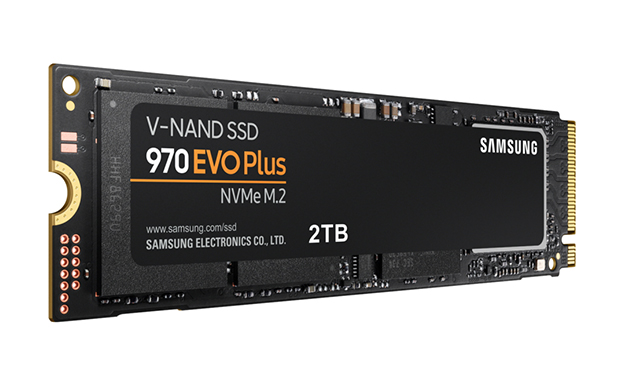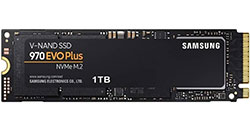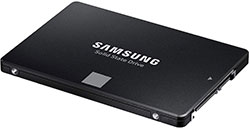The Samsung SSD 970 EVO Plus supplemented the manufacturer’s SSD storage portfolio as an optimized 970 EVO at that time. The Samsung SSD 980 now appears as the successor generation of the same EVO series. But how do the two NVMe drives differ from each other in detail? What are the advantages and disadvantages of the Samsung SSD 980 and the Samsung SSD 970 EVO Plus in comparison?
- ADS -
Advantages of the Samsung SSD 980 compared to the Samsung SSD 970 EVO Plus
- Enlarged SLC cache buffer memory
- Lower prices on average
- Lower cost per gigabyte
Advantages Samsung SSD 970 EVO Plus compared to Samsung SSD 980
- Internal DRAM cache memory
- Partially faster read and write speeds
- Better performance without TurboWrite
- Version with 2 TB memory size available
find best buy SSD on Amazon.com #ad
shop worldwide on | Amazon.com #ad | computeruniverse.net | eBay.com | AliExpress.com |
Similarities in interface and format
In terms of form factor as well as interface, the Samsung SSD 970 EVO Plus and the Samsung SSD 980 follow the usual standards that have long been established for NVMe drives. Both SSD hard drives correspond to the M.2 2280 plug-in card format with their outer dimensions of 80 millimeters in length and 22 millimeters in width. Both the 980 and the 970 EVO Plus are connected to the system via the PCIe Gen 3.0 protocol with 4 lanes. The 3-bit TLC NAND is used as the flash memory type in each case.

Differences in DRAM cache and SLC cache
The biggest difference between the Samsung SSD 980 and the Samsung SSD 970 EVO Plus is the lack of internal DRAM cache memory in the former. As a replacement, unlike the 970 EVO Plus series, the manufacturer relies on the use of HMB (Host Memory Buffer) technology in the 980 series, which gives the SSD direct access to system memory, while also significantly expanding the TurboWrite buffer area, which serves as an SLC cache of write performance acceleration.
Comparison of performance and features
While the Samsung SSD 980 can still keep up well with the Samsung SSD 970 EVO Plus in sequential reads with up to 3500 MB/s, the gap in writes is still worth mentioning. The older SSD generation is also ahead in performance without TurboWrite technology. In contrast, the two NVMe SSD series from Samsung are identical in the offered warranty period of 5 years. The available storage capacities start at 250 GB and end at 1 TB for the Samsung SSD 980 and at 2 TB for the Samsung SSD 970 EVO Plus.

Comparison of read and write speeds
| product / model | Samsung SSD 980 | Samsung SSD 970 EVO Plus |
| sequential read with PCIe 3.0 |
2.900 MB/s (250 GB) 3.100 MB/s (500 GB) 3.500 MB/s (1 TB) |
3.500 MB/s |
| sequential write with PCIe 3.0 |
1.300 MB/s (250 GB) 2.600 MB/s (500 GB) 3.000 MB/s (1 TB) |
2.300 MB/s (250 GB) 3.200 MB/s (500 GB) 3.300 MB/s (1 TB, 2 TB) |
| sequential write with TurboWrite |
250 MB/s (250 GB) 500 MB/s (500 GB) 900 MB/S (1 TB) |
400 MB/s (250 GB) 900 MB/s (500 GB) 1.700 MB/s (1 TB) 1.750 MB/s (2 TB) |
Conclusion SSD comparison – Samsung SSD 980 and Samsung SSD 970 EVO Plus differences
Even after years after its release, the Samsung SSD 970 EVO Plus does not lose its appeal thanks to the very good price-performance ratio. The Samsung SSD 980 should not be seen as a competitor product, but rather as an addition to the manufacturer’s range. Thus, the 980 without PRO takes over the task of a cheap entry-level SSD that opens the world of NVMe drives to all price-conscious buyers. The 970 EVO Plus remains the all-rounder that is aimed at both professional users and everyday users due to its reasonable cost per gigabyte and above-average performance.
find best buy SSD on Amazon.com #ad
shop worldwide on | Amazon.com #ad | computeruniverse.net | eBay.com | AliExpress.com |
Samsung SSD 980 vs Samsung SSD 970 EVO Plus – Technical data comparison differences
| product / model | Samsung SSD 980 | Samsung SSD 970 EVO Plus |
| form factor | M.2 2280 SSD | M.2 2280 SSD |
| interface | PCIe Gen 3.0 x4, NVMe 1.4 | PCIe Gen 3.0 x4, NVMe 1.3 |
| capacity | 250 GB 500 GB 1 TB |
250 GB 500 GB 1 TB 2 TB |
| dimensions | 80,15 x 22,15 x 2,38 mm | 80,15 x 22,15 x 2,38 mm |
| controller | Samsung Pablo Controller | Samsung Phoenix Controller |
| NAND type | Samsung V-NAND 3-Bit MLC (TLC) | Samsung V-NAND 3-Bit MLC (TLC) |
| DRAM cache | – | 512 MB LPDDR4 (250 GB, 500 GB) 1 GB LPDDR4 (1 TB) 2 GB LPDDR4 (2 TB) |
| TurboWrite cache | 45 GB (250 GB) 122 GB (500 GB) 160 GB (1 TB) |
13 GB (250 GB) 22 GB (500 GB) 42 GB (1 TB) 78 GB (2 TB) |
| sequential read | 2.900 MB/s (250 GB) 3.100 MB/s (500 GB) 3.500 MB/s (1 TB) |
3.500 MB/s |
| sequential write | 1.300 MB/s (250 GB) 2.600 MB/s (500 GB) 3.000 MB/s (1 TB) |
2.300 MB/s (250 GB) 3.200 MB/s (500 GB) 3.300 MB/s (1 TB, 2 TB) |
| sequential write after TurboWrite | 250 MB/s (250 GB) 500 MB/s (500 GB) 900 MB/S (1 TB) |
400 MB/s (250 GB) 900 MB/s (500 GB) 1.700 MB/s (1 TB) 1.750 MB/s (2 TB) |
| random read (QD1) | 17.000 IOPS | 17.000 IOPS (250 GB) 19.000 IOPS (500 GB, 1 TB, 2 TB) |
| random write (QD1) | 53.000 IOPS (250 GB) 54.000 IOPS (500 GB, 1 TB) |
60.000 IOPS (250 GB, 500 GB, 1 TB) 62.000 IOPS (2 TB) |
| random read (QD32) | 230.000 IOPS (250 GB) 400.000 IOPS (500 GB) 500.000 IOPS (1 TB) |
250.000 IOPS (250 GB) 480.000 IOPS (500 GB) 600.000 IOPS (1 TB) 620.000 IOPS (2 TB) |
| random write (QD32) | 320.000 IOPS (250 GB) 470.000 IOPS (500 GB) 480.000 IOPS (1 TB) |
550.000 IOPS (250 GB, 500 GB, 1 TB) 560.000 IOPS (2 TB) |
| reliability (MTTF) | 1,5 million hours | 1,5 million hours |
| TBW | 150 TB (250 GB) 300 TB (500 GB) 600 TB (1 TB) |
150 TB (250 GB) 300 TB (500 GB) 600 TB (1 TB) 1.200 TB (2 TB) |
| warranty | 5 years limited | 5 years limited |
| model code / part number | MZ-V8V250BW (250 GB) MZ V8V500BW (500 GB) MZ V8V1T0BW (1 TB) |
MZ-V7S250BW (250 GB) MZ-V7S500BW (500 GB) MZ-V7S1T0BW (1 TB) MZ-V7S2T0BW (2 TB) |

